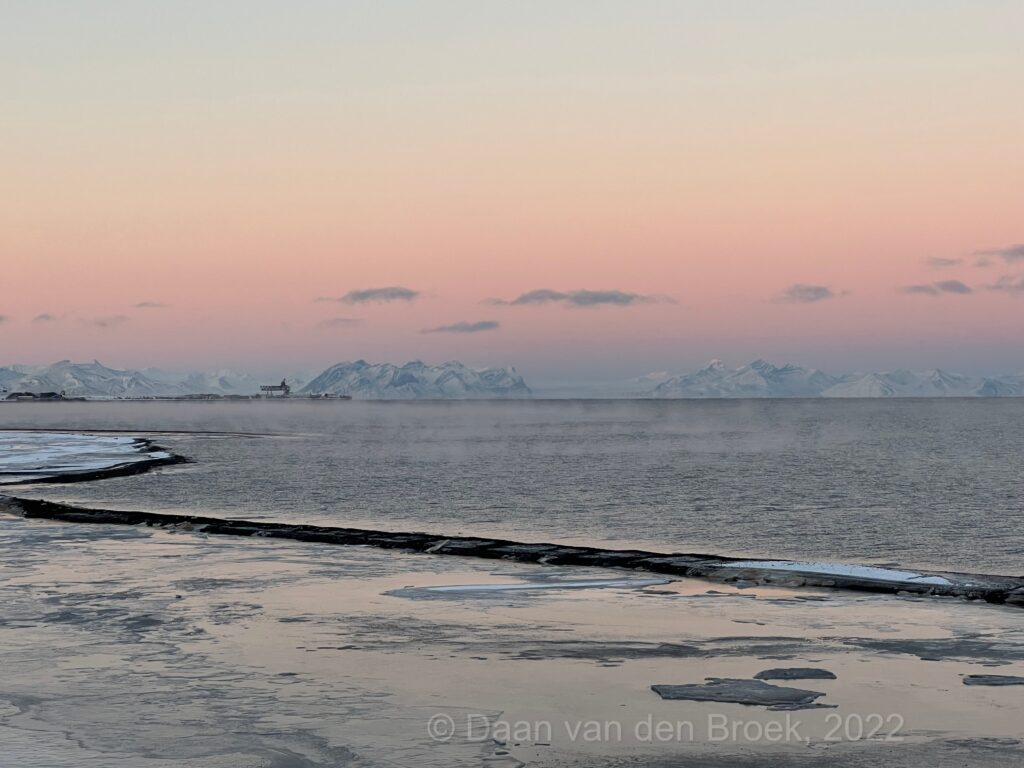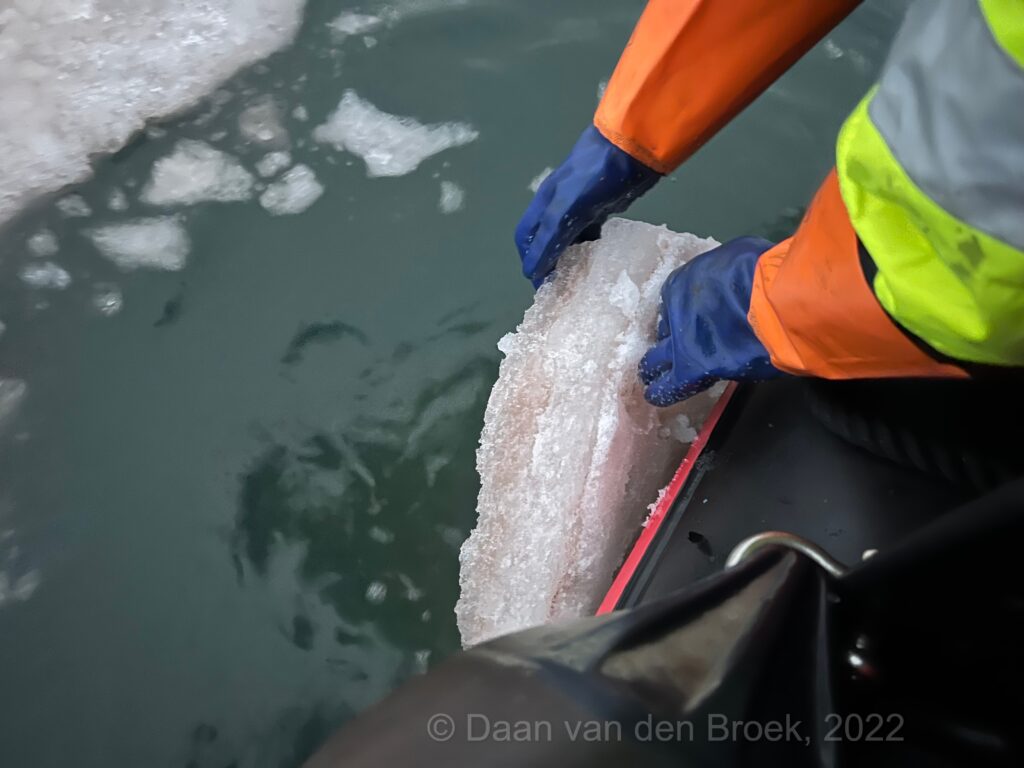In the fall of 2022, from October to December, I went to Svalbard to take part in the UNIS master course Air-Ice-Sea Interactions II. It was an incredibly exciting and educational two months, during which I specialized a bit more into (Arctic) oceanography and sea ice and the interaction between those fields and the atmosphere. For this course, we also went on a scientific cruise. In this article I reflect on my experiences: the study, a scientific cruise, cold and extremely mild weather, and also epic hikes and northern lights.
I have a particular fondness for Svalbard. In 2018, I studied there once, from August to December. As part of my bachelor’s program in Wageningen, I was able to go on an exchange for a semester. At that time, I took the courses Polar Meteorology and Polar Ocean Climate (see here and here). I arrived during the midnight sun and left in the polar night. Since then, Svalbard has won my heart. After the special experiences I had there, I returned twice as a tourist: in the summer of 2019 and the spring of 2022. The extremes of the Arctic island never bore, and I will never forget the memories I have made.
During this last visit in spring 2022, I met some people that told me about the course Air-Ice-Sea Interactions II, that was given in the following fall. I decided to sign up, and got accepted. In this way, I got the opportunity to specialize in oceanography and sea ice at UNIS in Svalbard, as part of my master studies at the University of Helsinki.
After transiting through Stockholm Arlanda, Oslo and a short stop in Tromsø , I arrived on Svalbard on Tuesday, October 18th. The course would only start on Monday, so I had a week to settle down and enjoy Longyearbyen and its surroundings. At the Arlanda airport, I met my mom who arrived there from the Netherlands. After hearing my stories that followed from visiting Svalbard several times, she wanted to experience the place with me.
Before my course began, I took the opportunity to enjoy some classic tourist experiences. Alongside my mother and my girlfriend, who was also in Svalbard for research purposes, we partook in a number of activities: a boat trip to the imposing Nordenskiöldbreen (glacier), a quad tour, and a ride on a dog sled – on wheels, as there was no noteworthy snow yet despite the cold.
Safety training and course start at UNIS
The course began the following week. It was a quite cold period at the end of October – even by Svalbard standards, the temperature was on the lower side for the time of the year. At its lowest, the temperatures even plummeted towards -15 degrees. The course started, as is customary, with a safety course. You learn how to provide first aid, what to do in case of hypothermia (and especially how to prevent it), and finally, what to do in case of an encounter with a polar bear. A part of this last topic was a shooting course: if there really is no other option, you should be able to defend yourself with a firearm. While many small snowflakes were fluttering down, we tried to shoot as accurately as possible at the set targets. In between shooting, we walked to the targets to check our results. The imposing bangs of the guns gave way to an imposing, disarming silence.
Scientific cruise
After the first week of safety training and lectures, we set off on a scientific cruise. During this boat trip, which lasted from Monday to Saturday evening, we visited Isfjorden and many of its side fjords. We primarily conducted CTD measurements (Conductivity, Temperature, Depth), a device that measures the conductivity (to then determine the salt content), temperature, and pressure (to infer the depth) of the water. We worked in shifts, day and night shifts. In some places, the fjords were too shallow for the impressively large ‘Polarsyssel’ ship. To still conduct measurements, we went on a smaller boat and performed manual CTD measurements with a smaller device. The trips with the small boat were the highlights of the week for me.
The cruise in itself was an incredible experience and beneficial for the students, who are essentially fledgling scientists. We were tasked with significant responsibilities such as conducting measurements and formulating plans, contributing directly to the general procedures and structure on the ship. In addition, at the beginning and end of each day, the students held briefings to discuss the weather forecast, share changes to the plan if any, and present preliminary measurement results. These hands-on experiences provided a valuable foundation for our future (scientific) careers.
Apart from these study and training-related experiences, there was sometimes also a little time to admire the surroundings. During our cruise, we saw strong northern lights at one point, but it was difficult to perceive with the naked eye because there were many strong lights shining on the deck of the ship. Given the mutual respect between the hardworking crew and our group, that strictly adhered to the crew’s rules and guidelines, the crew responded positively to our request to turn off the lights temporarily. Since we were on our way to the next measurement location and thus had no other tasks, we could enjoy a thrilling lightshow.
The mountainous surroundings also had a beautiful and often mysterious appearance: the polar night had started the week before, so there was no more daylight than some twilight in the middle of the day. The weather cooperated in the sense that the wind kept calm. Nobody suffered from serious seasickness. However, a southerly wind brought in very mild air, leading to alternating periods of snow and rain.
On to the measurements!
The measurements we have done have a dual purpose. First, we use the results for our course. The students were divided into 5 groups. Each group dealt with one fjord. Based on the measured data and a model, we had to estimate when the respective fjord would be first covered with ice. In a report and presentation, we presented our findings. During our cruise, we saw some sea ice in a few places.
Furthermore, our measurement data also ends up in a data archive. Scientists from around the world, but specifically from the University Centre in Svalbard (UNIS) can use this data for their own research. The data can, for example, be compared with data from the past or data that will be measured in the future. In this way, we can learn more about, among other things, the oceanographic properties of the fjords.
Hikes, northern lights, and more study
The study continued after the cruise. We had both lectures and group work on the aforementioned project. The lectures were given by multiple teachers with different areas of expertise. In this way, we learned optimally about matters such as sea ice, remote sensing (especially satellites), oceanography, and the atmosphere, but especially the relationship between all these subjects.
The week before the cruise, we still had some more light during the day. These photos were taken before the cruise.
Apart from the study, there was also time for adventures, mainly during the weekends. During the 6 weeks we had, we’ve made several hikes, with a hike to Trollsteinen being the highlight. The sun, as said, didn’t rise anymore, but in the middle of the day, we stood on top of the 850-meter high mountain. Looking in one direction, the sky was dark blue, while on the southern horizon a beautiful orange glow prevailed. It felt as if we could see the sun if we had stood one mountain peak further to the south.
During the hikes, we also visited ice caves multiple times, which are located in the glaciers around Longyearbyen, the capital of Svalbard with a population of 2,500 people. Sometimes in the evenings, we were lucky enough to perceive some weak northern lights, but the greatest spectacle waited one of the last weeks.
Green and purple light, dancing right above Longyearbyen
One Friday night, on the way to the local brewery – the most northerly brewery in the world – a fellow student noted that the northern lights were visible. It was brighter than we had seen throughout the entire period of studies so far. The fact that we could perceive it from the village itself says enough, because the bright lights in the city greatly hinder the sight of northern lights. On the way to the brewery, we kept stopping to admire this spectacle of nature. And in the end, we arrived at the brewery 15 minutes later than planned.
What we could never have foreseen was that the greatest spectacle was yet to come. We were incredibly fortunate – as soon as we exited the brewery, the Northern Lights dramatically intensified in their activity. Although I’ve been lucky enough to admire the northern lights several times, both in Finland and in Svalbard, I saw things I’d never seen before. For the first time, I could perceive not only the green but also the purple northern lights with the naked eye. The northern lights sometimes danced right above our heads, while they are usually more visible towards the horizon in Svalbard. At one point, we were lying on the ground so that we could look straight up and admire the show right above us.
The spectacle continued. Pillars of green and purple light danced high in the sky, split, disappeared, and reappeared elsewhere. It truly was a magical experience. An hour later (and with icy limbs, because it was nearly -10°C), the northern lights ‘finally’ subsided. One of the most spectacular evenings of my life thus came to an end.
Finishing up course Air-Ice-Sea Interactions II
Earlier on that spectacular Friday, we had presentations of our group work. Exams followed the week after. The last days of our stay, the winter finally returned with rain making place for snowfall again. Our classmates and I enjoyed some last walks through town together, attended Longyearbyen’s ceremony to celebrate Santa’s return to town on the first on advent and played in the snow. Just before I left, I made sure to get my copy of Line Nagell Ylvisåker “My World is Melting”.
It was yet another great time on Svalbard and another great learning experience studying at UNIS. I thank UNIS, the teachers and my fellow students for a great time!
Are you planning to study at UNIS yourself? Read here how to prepare yourself for studies on Svalbard!


























